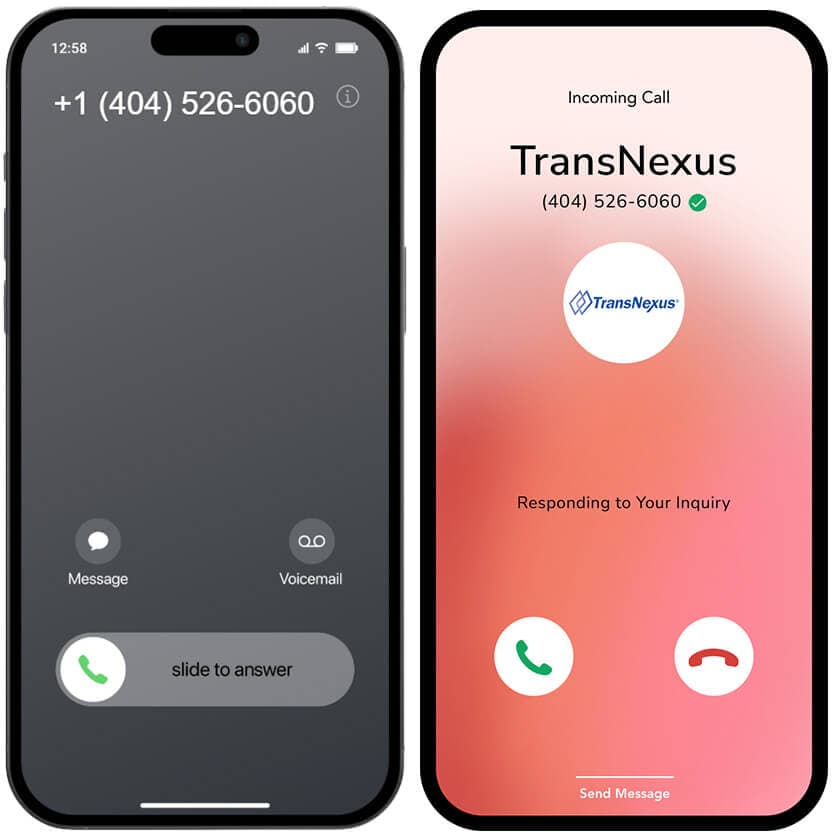Building trust in branded calling
There’s a growing interest in branded calling to improve call completion. But can branded calling information be trusted? This article reviews the issues and a proposed way to build trust. Let’s have a look.
Branded calling benefits
It’s easy to understand the growing interest in branded calling. Imagine a caller gets a call with only the calling number to identify the caller.
Which call would you answer?

Figure 1. Unbranded and Branded Calls
Many callers might not answer the call on the left. Who is that?
But add branded calling information in the call on the right and many callers might change their mind. They know who’s calling (TransNexus) and why (Responding to Your Inquiry). I’d take that call.
Branded calling can provide significant benefits to callers:
- The brand name is presented to the caller—improved answer rates.
- The caller’s name is accurate and on-brand—better than CNAM.
- Branding information can include a company logo image and call reason—creates a brand impression and persuades the recipient to answer the call.
- Can eliminate the “spam likely” tags that plague a brand’s calling efforts.
- The technology can ensure that branded calling information is not presented on illegitimate spoofed calls—further protecting the brand.
Branded calling benefits the called party too:
- They know who’s calling and why—better telephone experience.
- Telephone communication is valuable—when they know who’s calling.
Branded calling benefits voice service providers:
- Enhances the value of the voice service that Originating Service Providers (OSPs) sell to their customers.
- Branded calling capable OSPs have market advantages in providing branded calling services.
- These advantages can be realized through service fees, new customer acquisition, and customer retention.
- Terminating Service Providers (TSPs) can save money on CNAM dips—use the branded caller name instead.
Branded calling risks
Bad actors sometimes use impersonation or spoofing to increase the odds that their targets will answer their calls.
The benefits of branded calling are so compelling that bad actors will try to find ways to put branded calling information on their scam calls too.
To make branded calling successful, it needs to be built and delivered in a way that ensures that it can be trusted.
Building trust
Here are the steps that ensure that branded calling information is legitimate, accurate, and trustworthy:
- Vet the caller
- Validate caller telephone number(s) used on branded calls
- Validate that the branded calling information is accurate, that the caller is entitled to use it, and that it does not contain inappropriate content.
- Caller display name
- Call logo image
- Call reason
The vetting and validation process might be performed by a voice service provider or a third-party vetting and validation agent. There’s a growing interest in using certified third-party vetting agents for these reasons:
- OSPs don’t have to ramp up the staff and systems to perform vetting.
- Brands can be vetted once with a vetting agent, rather than with each OSP that they might use.
- TSPs might trust branded calling information more if they know that it was vetted and managed in an ecosystem with certified third-party vetting agents.
For more information on these trust-building measures, see CTIA Branded Calling ID™ Best Practices.
TransNexus software enables branded calling now. Contact us today to learn more.

TransNexus solutions
TransNexus is a leader in developing innovative software to manage and protect telecommunications networks. The company has over 25 years’ experience in providing telecom software solutions including branded calling, toll fraud prevention, robocall mitigation and prevention, TDoS prevention, analytics, routing, billing support, STIR/SHAKEN and SHAKEN certificate services.
Contact us today to learn more.
Branded calling optimizes call completion and callback.
Learn more about branded calling